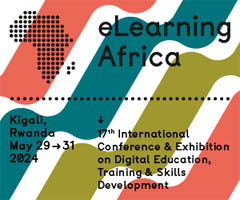High-Quality Content Will Prevail over Time

 Saarbrücken (GER), May 2016 - Some experts involved in digital training say that producing costly eLearning content is a thing of the past: creating hours of training in movie quality is simply too expensive. Target audiences consisting of young learners need little bites of training that present content in a concise and easy-to-grasp manner. But will these bites, which are known as learning nuggets, be sufficient to reflect complex learning needs? And what concept will future learning content be based on in order to engage and motivate learners, while meeting the increasingly complex requirements of organizations in terms of on-the-job training at the same time? Christian Wachter, CEO of IMC AG in Saarbrücken, Germany, and Sven R. Becker, Sales Professional at IMC, talk about learning contents of the future and stand up for high-quality eLearning content.
Saarbrücken (GER), May 2016 - Some experts involved in digital training say that producing costly eLearning content is a thing of the past: creating hours of training in movie quality is simply too expensive. Target audiences consisting of young learners need little bites of training that present content in a concise and easy-to-grasp manner. But will these bites, which are known as learning nuggets, be sufficient to reflect complex learning needs? And what concept will future learning content be based on in order to engage and motivate learners, while meeting the increasingly complex requirements of organizations in terms of on-the-job training at the same time? Christian Wachter, CEO of IMC AG in Saarbrücken, Germany, and Sven R. Becker, Sales Professional at IMC, talk about learning contents of the future and stand up for high-quality eLearning content.
Mr. Wachter, if you believe what certain experts have to say, it is no longer fashionable to produce high-quality eLearning content. Do you agree?
Christian Wachter: No, I do not think that one could say so at all. As a producer of digital learning content, it cannot be our goal to produce eLearning modules that match motion pictures in both quality and length and then attempt to justify the costs of doing so to our clients. We are, however, of the opinion that engaging, high-quality, and tailored content is absolutely necessary when it comes to reacting to the individual learner’s needs.
Depending on the type of content, this can, of course, be done in smaller training bites that are suitable for learning on the go or for completion during less busy times at work. It is a fact that these learning nuggets are used quite widely at the moment, and this very clearly shows us that shorter learning formats most certainly hold a valid position within eLearning. However, you should ask yourself about the learner’s background before deciding on a particular format. When talking about "quality" in terms of digital learning content, in addition to adjustments to specific learning needs, "modularity" as a quality measure should be taken into consideration. "Modularity" here means that individual teaching modules are within a concept following a certain "learning logic" and structure but can be used separately, too.
Curating learning content means to identify, organize, and comment on valuable learning content, as well as making the content available to suitable target audiences. Some consider this principle to be an important long-term trend regarding digital learning content. From your perspective, what do you think can be achieved through curating, and which added value does it provide?
Christian Wachter: From our perspective, curating good learning content is a valid process. Such a concept clearly builds on the manifold formats and uses content already available on informal platforms like Slideshare or YouTube, as well as content available on in-house platforms. Despite the clear advantages, for example its interactive character and its relevance, we are still of the opinion, that learners have a right to an individually tailored learning concept for their individual work scenario on top of "recycled" material. Curated learning content only partially addresses these needs.
If you were to give an outlook on successful learning formats in the future, what kind of features should be delivered?
Sven R. Becker: In any case, digital content will become much more intelligent. It can already be observed today that learning content per unit is getting smaller and that learning nuggets play a more and more important role. At the same time, the concept behind it is literally becoming "smarter". Back in the "old days", digital objects were re-digitalized without paying much attention. This meant that a PDF would be converted into eLearning content without considering whether this actually helped achieve the learning target.
These days, content creation moves in a different direction, with content design being a lot simpler, taking advantage of a smarter concept in the background. From a didactic standpoint, this means, for instance, that trainings are much more scenario based and offer learners the possibility to move through a real workflow. Thanks to this lifelike setting, the learner can clearly see the value obtained by working through a specific learning module. Such a concept can also be included in the smallest form of scenario-based learning, the learning nugget. Curated content cannot deliver the same results here.
What can users expect from such a small scenario-based learning nugget?
Sven R. Becker: Behind the scenario character of learning content lies, not least, the need to lead the learners during the learning process or to guide them. These days, we more often than not expect digital natives to use “informal learning” to individually get acquainted with a subject by searching and reviewing related information online in order to identify necessary learning content - and this might actually be fruitful to some extent. But once the need arises for the learner to test any number of scenarios in order to receive feedback or answers, a clearly defined learning path becomes inevitable. And this learning path should contain learning content that follows an elaborate and tailored approach.
Quality and an elaborate, holistic concept will play an important role in the future and might even become more important than we are able to foresee now. The interactive character of teaching units capable of reacting to the users’ answers and decisions is another advantage here, which results in additional user motivation by highlighting interdependencies. This, for instance, includes a sales rep testing the clients’ reactions in a small dialogue by giving a certain answer. Depending on the learner’s reaction in this situation, the simulation might take a totally different turn.
For a large number of topics, it might sometimes be sufficient to read an article on Wikipedia or to watch a how-to video online. But this does not always cover the need to test the results of certain decisions in a lifelike situation. This is, however, what the young generation of "gamers" expects good learning content to deliver - and what we believe they have a right to expect.
Christian Wachter: Exactly. And the content market has already adapted to these recent needs. Smart new learning formats like nutshell training, learning cards, and intelligent mini-game formats show interdependencies and can easily be accessed on tablets or smartphones. They clearly show that good content does not need to be expensive or complex, but simply needs to be well done and “intelligent”.
Sven R. Becker: To summarize, we believe that in the future it is likely that many trends will coexist. Curated forms of learning and informal learning will hold a valid position next to formal learning formats; however, they will not always be sufficient to meet any and all training demand. This is why we at IMC believe in the future of coherent and elaborate blended-learning concepts that combine all these options in a harmonized way to guarantee the future of successful trainings.









